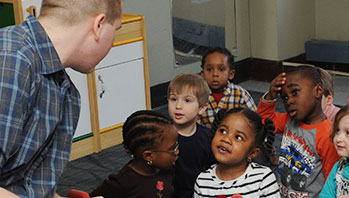- containers for pouring
- items like sticks to change the way water flows
- large clear plastic tub
- plank of wood or plastic sheet to use as a ramp
- water
- downhill
- flow
- pour
MA Standards:
Speaking and Listening/SL.PK.MA.1: Participate in collaborative conversations with diverse partners during daily routines and play.
Language/L.PK.MA.6: Use words and phrases acquired through conversations, listening to books read aloud, activities, and play.
Head Start Outcomes:
Language Development/Receptive Language: Attends to language during conversations, songs, stories, or other learning experiences.
Language Development/Expressive Language: Uses language to express ideas and needs.
Logic and Reasoning/Reasoning and Problem Solving: Classifies, compares, and contrasts objects, events, and experiences.
PreK Learning Guidelines:
English Language Arts/Language 2: Participate actively in discussions, listen to the ideas of others, and ask and answer relevant questions.
Talk Together: Flowing Downhill

© Commonwealth of Massachusetts, Department of Early Education and Care (Jennifer Waddell photographer). All rights reserved.
STEM Key Concepts: Water flows downhill; You can change the direction water flows; You can use different objects to move water
ELA Focus Skills: Listening and Speaking, Vocabulary
Educator Prep: Before beginning the activity, fill the large tub with about four inches of water. Put various containers in the water. Place the container on a low table so children can reach the water. Place the wood/plastic plank at an angle in the tub.
Remind children of their ramp explorations. Invite them to describe what happened when they put a ball at the top of the ramp. Then tell children they are going to explore how water flows down a hill or slope. Draw children’s attention to the materials and point to the ramp.
Ask children, What do you think will happen if I pour water at the top of this ramp? Discuss children’s predictions. Then pour the water at the top of the ramp and ask children if the water flowed like they predicted. Ask questions such as,
- Do you think water always flows straight down?
- Have you ever seen water flow in a different direction? When?
- If I poured the water onto the ramp again, what do you think it would do?
- Is there any way I could make it flow a different way? How?
Say that water flows downhill by itself, but it can sometimes be made to change direction. How do you think you might change the direction of the water when it is flowing downhill? Record children’s responses. Then tell them they are going to go outside to explore how they can change the direction of the water flow.
